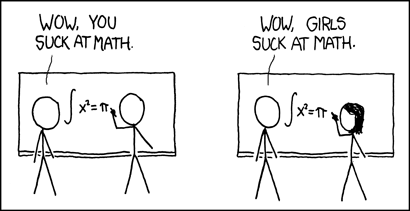Who wants to be an engineer?
The fields of Science, Technology, Engineering and Mathematics, known collectively as STEM, underpin the most lucrative and fastest growing industry sectors in the world. According to a report published by Pew Research (Funk & Kim 2017), STEM-related sectors have grown 79% since 1990 in the US alone and are expected to grow another 13% in the next five years outpacing non-STEM sectors by a 5% gap. Those employed in STEM can expect to earn more than twice that of similarly educated non-STEM peers. Of the 17.3 million STEM employees in the US, only 24% are women, a figure that masks further demographic imbalances. Minority women, especially blacks and hispanics, for example, are grossly underrepresented, with only 6.5% in Science, 4.8% in Tech, 3.1% in Engineering and 5.4% in Math.
The OECD Program of International Student Assessment (Pisa) report from 2015 shows that in 65 out of 67 countries, boys out-performed girls in maths and science by 19 points or the equivalent of half a school year (Mostafa 2019). However when results were compared between girls and boys who reported the same levels of confidence in the subject, the differences disappeared (OECD 2015). Studies show that implicit gender biases are already cemented in children by about the age of 7 or 8 (Corbett and Hill 2015). In several studies (Steele 2003, Aguilar et al. 2016, Picker and Berry 2000), when asked what a mathematician looks like, for example, children were twice as likely to draw men. A 2008 report by the National Academy of Engineering (NAE 2018) asked children aged 9–11 if they wanted to be an engineer, and found that girls were twice more likely than boys to say “no”. However, when asked if they would like to design a safe water treatment plant, save the rainforest, or solve crimes using DNA, the girls said “yes”. Furthermore, girls are affected by “stereotype threat” (Spencer et al. 1999), depicted below in the cartoon from xkcd.com, and show a disinclination to take risks for fear of contributing to the negative stereotype that affects their group (Reardon et al. 2018). In short, the problem of low numbers of girls choosing to study STEM subjects is linked not to their ability, but to their confidence, the lack of visibility of the social dimension of STEM, and a tendency to underestimate their own abilities.
Educators are addressing this by using creative teaching practises. One such example is “academically productive” conversation, facilitated by teachers using “talk moves” in class. Talk moves are phrases and questions that foster an environment of active listening, contextualisation of complex ideas, collaborative learning, and the respectful construction and delivery of explanations, arguments and counter-arguments. Academically productive discourse especially helps girls maintain an interest in mathematics by providing a social context that has been shown to improve girls’ self-assessment of their mathematical abilities. This can lead more women and minorities to choose STEM career paths resulting in a positive societal effect, injecting much-needed diversity into increasingly homogeneous STEM fields.
References
Funk, Carey and Parker, Kim. (2017). “Pew Research Center STEM survey” https://www.pewsocialtrends.org/dataset/2017-pew-research-center-stem-survey/
Mostafa, T. (2019). “Why don’t more girls choose to pursue a science career?”, PISA in Focus, No. 93, OECD Publishing, Paris, https://doi.org/10.1787/02bd2b68-en.
OECD (2015). The ABC of Gender Equality in Education: Aptitude, Behaviour, Confidence, PISA, OECD Publishing, Paris, https://doi.org/10.1787/9789264229945-en.
Corbett, Christianne and Hill, Catherine. (2015). ”Solving the Equation: The Variables for Women’s Success in Engineering and Computing”, American Association of University Women (AAUW), https://www.aauw.org/aauw_check/pdf_download/show_pdf.php?file=solving-the-equation
Steele, Jennifer (2003). Children’s Gender Stereotypes About Math: The Role of Stereotype Stratification. Journal of Applied Social Psychology, 33: 2587-2606. doi:10.1111/j.1559-1816.2003.tb02782.x
Aguilar, M.S., Rosas, A., Zavaleta, J.G.M. et al. (2016). Exploring High-achieving Students’ Images Of Mathematicians, International Journal of Science and Math Education 14: 527. https://doi.org/10.1007/s10763-014-9586-1
Picker, S., & Berry, J. (2000). Investigating Pupils’ Images of Mathematicians. Educational Studies in Mathematics, 43(1), 65-94. Retrieved from http://www.jstor.org/stable/3483234
Committee on Public Understanding of Engineering Messages, National Academy of Engineering (NAE) (2008). Changing the conversation: Messages for improving public understanding of engineering. Washington, DC, US: National Academies Press.
Spencer, S. J., Steele, C. M., and Quinn, D. M. (1999). Stereotype threat and women’s math performance. Journal of Experimental Social Psychology, 35(1), 4-28.
Reardon, S.F., Kalogrides, D., Fahle, E.M., Podolsky, A., and Zárate, R.C. (2018). The Relationship Between Test Item Format and Gender Achievement Gaps on Math and ELA Tests in 4th and 8th Grade. Educational Researcher, 47(5).

